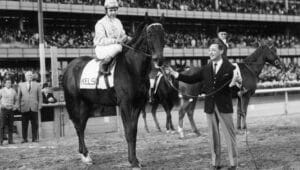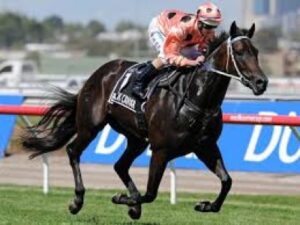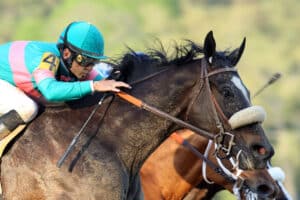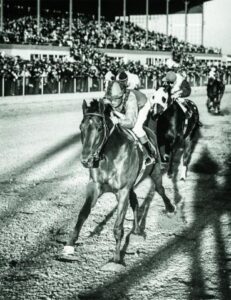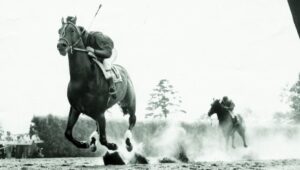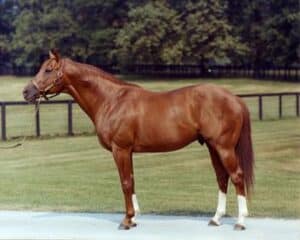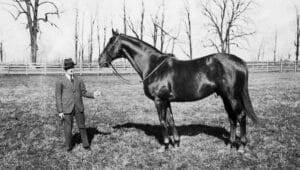Ranking the Best Racehorses of All Time
Horse racing has been around for quite some time. The first modern horse race took place in 1776 in England, known as the St. Leger race.
Since its beginnings in the 18th century, people worldwide gather each year to attend various horse races. Although thousands of horses compete in these races each year, only a few stand out to be defined as “history makers.”
Top 7 Greatest Racehorses of All Time
Based on their achievements, records, and industry legacy, we’ve compiled a list of the top 7 greatest racehorses of all time.
#7: Kelso: The Unexpected Victor
Kelso was deemed the unexpected victor. When he was born, he was considered a runt. He was certainly not what anyone would expect to become a reigning champion in the racing world.
Affectionately called “Kelly” and “King Kelly” by his owners, he was a bay gelding. Kelso was owned by the Dupont family and raced for 8 seasons. Kelso won 39 of his 63 starts.
Many racehorses in history were known for their looks, but that was not the case for Kelso. As far as looks, Kelso was considered an average horse. However, when Kelso started moving, there was no denying just how impressive he really was.
Born: April 4, 1957
Color: Dark Bay
Sex: Gelding
Pedigree: Your Host x Maid of Flight (whose damsire was none other than Man O’War)
Notable Trainer: Dr. John Lee
Iconic Win: Jockey Club Gold Cup (1960, 1961, 1962, 1963, and 1964)
Economic Impact: Impressive earnings ($1,977,896)
Did You Know? When Kelso retired, he was the highest monetary earner of all time. This was despite him never competing in a Triple Crown event (he was passed by Affirmed in 1979)
Racing Career Highlights:
- 11 Consecutive wins in 1960 and 1961
- Kelso won 39 out of 63 starts (an impressive 62%)
- Kelso was voted Horse of the Year for five years straight during the 1960s
- Kelso set an American record for a mile and a half turf in 1964 (2:23 4/5), winning the Washington D.C. International. He later went on to set the world record for 2 miles
- Holds 9 track records
- Five-times winner of the Horse of the Year title
#6: Black Caviar: Undefeated Champ
Black Caviar was a bay filly that retired in 2013 with a record of 25-0. She was trained by Peter Moody, who was based out of Melbourne, Australia. The highlight of her career is when she traveled to England and won the Diamond Jubilee Stakes.
Black Caviar was stout in build, but you would never think that when you saw her start to race. Although she was a stocky horse, when she was moving, she was fluid and light. Have you ever heard the famous saying, “Float like a butterfly, sting like a bee?” This quote was the essence of Black Caviar. She was powerful, yet graceful and extremely agile when she was racing.
Born: August 18, 2006
Color: Dark Bay
Sex: Mare
Pedigree: Bel Esprit x Helsinge
Notable Trainer: Peter Moody
Iconic Win: GBR Diamond Jubilee Stakes, 2012
Economic Impact: High estimated earnings ($7,953,936)
Did You Know? Black Caviar debuted as a two-year-old and won by five lengths
Racing Career Highlights:
- The first horse outside of Europe to win the European Champion Sprinter
- She set the Australian record for winning 15 Group I races
- Named the Australian Champion Sprinter
- Named the racehorse of the year in Australia for 3 consecutive years (2011-2013)
- Achieved an unprecedented 25-0 career record
#5: Zenyatta: The Queen of Racing
Zenyatta has been referred to as the “Queen of Racing.” She was named after the album titled Zenyatta Mondatta by the Police. Zenyatta was another bay filly that competed during the same period as Black Caviar. Although Black Caviar broke Zenyatta’s record for the number of consecutive wins, Zenyatta was a powerhouse to be reckoned with. Unlike many other racehorses in the industry, she didn’t race as a two-year-old. She was born in 2004 and didn’t race until 2007. Her career ended in 2010.
Zenyatta was a very large horse. She stood over 17 hands and weighed over 1200 pounds. She was infamous for her pre-race “dancing” routine. Many race watchers reported that during her career she would prance around happily as if she was putting on a dancing show for the crowds before she competed (we’ll blame this on being a mare and having lots of built-up energy that she needed to dance out).
Born: April 1, 2004
Color: Dark Bay/Brown
Sex: Mare
Pedigree: Street Cry x Vertigineux
Notable Trainer: John Shirreffs
Iconic Win: Vanity Handicap (2008, 2009, 2010)
Economic Impact: Total career earnings: $7,304,580
Did You Know? Due to her size, Zenyatta always felt claustrophobic at the starting gate
Racing Career Highlights:
- First mare to win at the Breeders Cup Classic
- Awarded Champion Older Female Horse for 3 consecutive years
- Awarded American Horse of the Year
- Set new records at Del Mar and the Lady’s Secret Stakes Race
- She won her 2007 debut at Hollywood Park by three and a half lengths
#4: Dr. Fager: The Speed Demon
Throughout the years, Dr. Fager has been awarded the nickname “Speed Demon.” He was a bay stallion, and he raced only for a couple of years (1966-1968). His trainer, John Nerud, named him after the neurosurgeon who operated on him after a tumble from a pony gave him some scary symptoms that would require brain surgery. Dr. Fager stood at 16.2 hands, and he is still considered one of the fastest racehorses that the world has ever seen.
Born: April 6, 1964
Color: Bay
Sex: Stallion
Pedigree: Rough’n Tumble x Aspidistra
Notable Trainer: John A. Nerud
Iconic Win: New Hampshire Sweepstakes Classic (1967)
Economic Impact: Significant earnings for the time ($1,002,642)
Did You Know? Dr. Fager was club-footed but that didn’t slow him down one bit during his races
Racing Career Highlights:
- New track records at the New Hampshire Sweepstakes Classic, Rockingham Special Stakes
- Set a new American record at the Washington Park Handicap
- Set a new world record at the Washington Park Handicap
- Named American Horse of the Year, American Champion Handicap Male, American Champion Turf Horse, and American Champion Sprinter
- Inducted into the National Museum of Racing’s Hall of Fame (1971)
#3: Citation: Legacy Runs in the Family
Citation was born out of Calumet Farm in Lexington, Kentucky. Back in 1941, the owner of Calumet Farm, Warren Wright Sr., purchased Hydroplane II from Britain. Hydroplane II was mated with Bull Lea, and foaled a bay colt, who would be named Citation. Mr. Wright could be called pretty lucky with the dynasty of horse racing that he created during his time. Within 3 years of being foaled, Citation won the Triple Crown in 1948. Although Mr. Wright bred many champions out of his stables, Citation was the star of the show.
Citation raced from 1947-1951. In a quick amount of time, he had established quite a reputation for himself. In fact, during one Stakes race that Citation attended, he was the sole competitor. Not because it was an unpopular race…but because Citation was commanding the horse racing world so much that no one wanted to compete against him.
Born: April 11, 1945
Color: Bay
Sex: Stallion
Pedigree: Bull Lea x Hydroplane
Notable Trainer: Ben A. Jones
Iconic Win: 1948 Triple Crown race wins (Kentucky Derby, Preakness Stakes, and Belmont Stakes
Economic Impact: Impressive earnings for the mid-20th century ($1,085,760)
Did You Know? Citation became the first horse to ever earn a million dollars
Racing Career Highlights:
- Champion 2-year-old and 3-year-old colt
- Triple Crown winner (the 8th winner)
- Named Horse of the Year in 1948
- Won 16 races consecutively
- Named Champion Older Male Horse in 1951
#2: Secretariat: The Epitome of a Dream Racehorse
Although Secretariat didn’t make it to our #1 spot as the best racehorse of all time, he is probably the most widely known racehorse name. Secretariat was a chestnut stallion that raced between 1972 and 1973. He was foaled in 1970, and he was affectionately referred to as “Big Red.”
Secretariat made his racing debut in 1972, and he quickly picked up traction after that. In his first race, he finished fourth. Just 11 days later, he competed in his second race and won. A couple of weeks later, he competed again in the third race of his career, and again, he won. Everyone in the horse racing industry was quick to note that Secretariat was special.
This incredible horse has been known as the racehorse that had it all. He was the textbook definition of perfect stature and athleticism, and he had a big heart… literally. After Secretariat was euthanized, the veterinarian discovered that Secretariat’s heart weighed between 21-22 pounds. The weight of his heart was over 2 and a half times the size of the average horse heart.
Secretariat is arguably the most popular racehorse of all time. There was even a movie made about him titled: Secretariat. During the peak of his fame, he received so much mail from fans that his owner hired a secretary to handle it all. They also hired an agency to manage Secretariat’s public engagements.
Born: March 30, 1970
Color: Chestnut
Sex: Stallion
Pedigree: Bold Ruler x Somethingroyal (By Princequillo)
Notable Trainer: Lucien Laurin
Iconic Win: 1973 Belmont Stakes (won by 31 lengths)
Economic Impact: Syndicated for a then-record $6.08 million; influence on breeding through his descendants.
Did You Know? Secretariat's heart was estimated to be 2.5 times the size of an average horse's heart.
Racing Career Highlights:
- Triple Crown winner (1973)
- Set records in all three Triple Crown races
- Named Horse of the Year in 1972 and 1973
- Featured on the covers of Sports Illustrated, Newsweek, and Time
#1: Man O’ War: The Best RaceHorse of All Time
Man O’ War raced from 1919 to 1921. To this day, he is considered the greatest racehorse of all time. Man O’ War was a chestnut stallion that won 20 out of his 21 races. One of his most notable victories was when he raced and won carrying 138 lbs.
Man O’ War was a total rockstar on the racetrack, and his appearance matched his abilities. He stood at 16.2 hands, weighed over 1,100 lbs., and had a 72-inch girth. It was commonly known that you could put Man O’ War on any terrain and at any distance, and he would win. Man O’ War comes in as the greatest racehorse in history over Secretariat. The main reason is that Secretariat raced with lightweight aluminum shoes, and Man O’ War raced in steel shoes. In addition, Man O’ War often carried extra weight during his races. So, Man O’ War was provided with more challenges, and he still came out on top.
Born: March 29, 1917
Color: Chestnut
Sex: Stallion
Pedigree: Fair Play x Mahubah
Notable Trainer: Louis Feustel
Iconic Win: Keene Memorial Stakes (1919)
Economic Impact: Earned $249,465 in total (equivalent to nearly $4 million today); had a profound impact on most existing American pedigrees due to his leading sire role after retirement
Did You Know? Man O’ War managed to win a whopping 9 out of 10 starts in 1919
Racing Career Highlights:
- Set the one mile and 3/8 record while carrying 128 pounds
- Won 16 stakes races
- North American leading sire in 1926
- Named American Horse of the Year, American Champion 3 Year Old Male Horse and Champion Two Year Old Colt
- Set a world record for one mile and 5/8
- Set a new record for one mile and 1/8
Who is Better, Man О’ War or Secretariat?
Man O’ War is the clear winner in our ranking. Based on several factors and achievements, he was a better racehorse than Secretariat, although the latter will forever be considered one of the greatest and fastest racehorses in the world.
Why is Man O' War considered better than Secretariat?
Man O’ War is considered better than Secretariat because of his impressive achievements despite numerous difficulties when compared to modern times. Back in his heyday, surfaces on racetracks were much tougher, and there were no modern starting gates, making it extra difficult for horses. Despite all this, Man O’ War won 20 of 21 starts in his relatively short career.
Has any horse beat Secretariat's record?
Secretariat's legendary 1973 Belmont Stakes victory is an amazing achievement. The 1.5-mile-long course is the longest of the Triple Crown races, and Secretariat managed to cover it for exactly 2 minutes and 24 seconds and achieved the most impressive victory margin at the same time (31 lengths). This record remains undefeated to this day.
Racehorse Breeds and Prices
Racehorse prices can vary a lot and are always based on several factors. The most important one is breed but the rest also play key roles in determining racehorse pricing. That list includes age, pedigree, racing history, achievements, and earnings.
Best racehorse breed
Thoroughbreds are the most popular and preferred racehorses. They were originally bred for racing in England and their pedigree comprising Arabians and Turks shows - thoroughbreds are athletic and have a distinct, impressive appearance. They’re also agile, fast, and boast enviable endurance.
Racehorse price
A racehorse can cost anywhere between a few thousand and a few hundred thousand US dollars but the median price of one is approximately $75,000. For example, a Thoroughbred racehorse in its prime can cost north of $300,000.
What racehorse breeds produced the fastest racehorses of all time?
The fastest racehorses are most often thoroughbreds. Secretariat is the best example we could give: this record-holding legend was capable of speeds of approximately 40 mph, making it the fastest racing horse in history. He averaged 37.5 mph when he set the 1973 Belmont Stakes record.
Transporting Champions: The Art of Moving History-Making Racehorses Retain existing content
Transporting legendary racehorses, known for their extraordinary achievements on the track, requires specialized care and attention. These equine athletes, having reached the pinnacle of racing history, need transportation that prioritizes their unique needs for safety, comfort, and stress-free travel.
Key Considerations in Racehorse Transportation
There are several crucial factors to consider when it comes to proper racehorse transportation. The key considerations below are essential for carrying out such a specific task.
Personalized Travel Plans
Each racehorse is an individual with specific needs. Tailoring travel plans to accommodate their unique requirements, such as preferred travel times and stops for rest, is crucial.
Veterinary Support
Continuous access to veterinary care during transit ensures the health and well-being of these valuable animals. This includes pre-travel check-ups and emergency medical care if needed.
Professional Handling
Expert handlers, familiar with the nuances of each horse, play a vital role in ensuring a calm and secure environment during transportation.
Travel Conditioning
Preparing racehorses for travel through conditioning helps them adapt to the journey, reducing stress and anxiety.
Double D Trailers: Custom Solutions for Elite Racehorse Transportation
Double D Trailers' gooseneck horse trailers rank number 1 in the list of best horse trailers for racing horses by The Sports Economist. Our horse trailers with living quarters come next as the ideal alternative.
Double D Trailers stands out in the field of racehorse transportation by offering highly customized horse trailers designed to meet the specific needs of elite racehorses. Our trailers are not just modes of transport but a testament to innovation and care in equine travel.
Unique Features of Double D Trailers
After years and years of introducing innovations to the horse trailer industry, embracing new technologies, and registering several patents, it’s easy to recognize Double D Trailers thanks to a collection of unique features, including:
Advanced Climate Control
Double D Trailers' climate control systems are specifically designed for the sensitive nature of racehorses, maintaining a stable environment regardless of external conditions.
Adaptable Interior Design
With adjustable partitions and customizable stall sizes, each trailer can be configured to suit the comfort and safety needs of individual horses.
State-of-the-Art Safety Features
From non-slip flooring to emergency exits, every aspect of a Double D Trailer is crafted with the horse's safety in mind. Advanced suspension systems ensure a smooth journey, reducing the risk of travel-related stress or injury.
Integrated Monitoring Systems
Owners and handlers can monitor their horses in real-time, ensuring immediate response to any signs of distress, thanks to the sophisticated camera and surveillance systems installed in each trailer.
Transporting racehorses isn't just about getting from point A to point B – it's an extension of the care and training that creates champions. Our trailers are designed with the horse's needs in mind, providing a smooth, stress-free journey befitting their star status. We know that every detail matters when your horse is aiming for greatness. By choosing Double D Trailers, owners and trainers ensure that their racehorses are transported in a setting that is as close to their home environment as possible, guaranteeing peace of mind and the highest standard of care during their journey.

